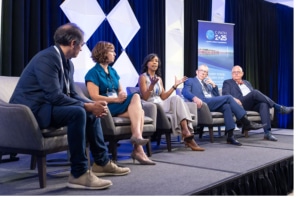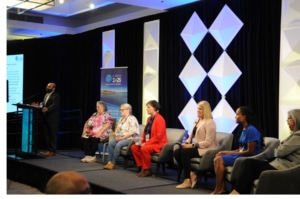
Day 1 of Critical Path Institute’s Global Impact Conference, #CGIC2025, opened with powerful conversations on accelerating therapies, amplifying patient voices, and strengthening public-private partnerships (PPPs) to address the most pressing needs in pediatrics and rare diseases.
We began with Accelerating Therapies for Disease Modification and Interception: Removing Barriers, Realizing Impact, moderated by Klaus Romero (C-Path).
Panelists from the FDA, EMA, Sanofi, and a patient organization explored how Public-Private Partnerships can bridge discovery with clinical application across the human lifespan. The discussion underscored opportunities to align regulators, enable earlier interventions, and overcome operational and financial barriers to developing therapies for at-risk populations.
“My daughter died and I want to give as much meaning to her life as possible,” said Julia Vitarello, founder of Mila’s Miracle Foundation. “Let’s use privacy ethics to help us offer more treatments, better treatments, and not create another barrier to why millions of children can’t be treated. Every single parent I’ve talked to, hundreds around the world, would all be very happy to know that their children’s lives were meaningful in helping the next child, and that means sharing every little bit of pre-clinical data possible.”
Next, in Ensuring a Focus on Patients in Pediatrics and Rare Disease Therapy Development, patient advocates and researchers highlighted strategies for designing trials that work for children and families. From understanding socioeconomic barriers to providing better support systems, the conversation emphasized how meaningful patient engagement can drive participation and shape the future of rare disease research.
The late morning session, Development of Gene-Based Therapies in Pediatrics, addressed the promise and challenges of regenerative treatments for young individuals. Panelists explored patient, disease, and regulatory factors, while also sharing strategies to ease the burden of trial participation for families.
During the lunch break, attendees joined three interactive breakout sessions:
- Implementing New Approach Methodologies (NAMs) in Drug Development: Use Cases and What’s Still Needed, showcased the promise of human-relevant tools and the need for validation, standardization, and collaboration to advance their use in regulatory decision-making.
- RDCA-DAP Taskforces: A Novel Small-scale Public-Private Partnership Approach for Rare Disease highlighted how targeted, data-driven collaborations can accelerate regulatory-grade solutions for rare diseases.
- What Happens After Approval? Rethinking Long-Term Follow-Up in Pediatric Gene Therapy explored innovative approaches to post-approval monitoring that balance scientific rigor with the realities of pediatric care.
In the afternoon, The Missing Voices in Neonatal Drug Development: Harnessing Patient Advocacy for Impact, highlighted the lived experiences of families navigating neonatal care. Their stories, combined with perspectives from advocacy leaders and regulators, emphasized the urgency of bringing the patient voice into neonatal drug development. This was followed by Mechanism-based Drug Development for Rare and Orphan Diseases That Affect Pediatric and Adult Populations, which explored how target and disease considerations shape study design and highlighted unmet needs in developing new treatments.

We closed with a Call to Action: Looking to the Future of Public-Private Partnerships for Pediatrics and Rare Diseases, where panelists reflected on Day 1 themes and discussed how to optimize global collaborations across disciplines. The conversation reinforced a central idea: PPPs remain vital to translating science into solutions for patients.
Day 1 reminded us that progress depends on the convergence of science, regulation, and patient experience — and together, we are building the foundation for a healthier future.
We look forward to continuing the momentum today in Day 2 sessions.


